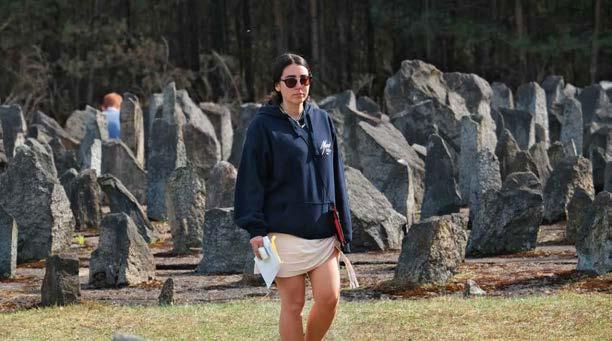
2 minute read
extracts from my MOtl jour nal
At M A jdA nek
Icould feel my eyes burning while walking through the gas chambers. I do not know whether it was from lack of sleep, or if the remains of the Zyklon B gas used by the Nazis are still present. Either way I, couldn’t even begin to think about the number of Jews that passed through those rooms. It could have been me, it could have been my friends, it could have been my family.
Advertisement
There was a window, but no light entered. Apart from me, the only sign of life was a butterfly trying to escape. There’s a poem written by children while they were living in Theresienstadt Concentration Camp about never seeing another butterfly. At Majdanek, I was seeing that butterfly, and it seemed as if it was flying for those who couldn’t. It reminded me of why this trip is called ‘March of the Living’; it is because we are living – living for those who cannot.
Seeing the little peephole that was used to oversee the gassing was incredibly confronting. That someone could stand there and watch the deaths of so many people, have the ability to prevent those deaths, but doing nothing and allow it to happen. I just can’t comprehend the sheer number of people who walked in here and never left.
In the crematorium, I saw another butterfly. There was light in this room, and windows, which almost made it worse as it was so easy for people to see what was going on. The butterfly reminded me that so many people didn’t even make it to that room alive.
Finally, seeing the ashes in the huge pit at the Majdanek Mausoleum really affected me. The ashes of only a tiny proportion of those murdered were here in front of me. I walked around the entire memorial just thinking and thinking about all those people. Others were there taking photos. It seemed disrespectful but, looking back, I can see that photos are important, even necessary, to educate others so that they cannot deny the Holocaust.
All 17 of our group, plus the cohort from New Zealand, formed a circle, linked arms and sang ‘Acheinu’ and ‘Hatikva’. I felt hurt, sadness and anger, but also empowerment. I cried so much that I couldn’t even sing those two meaningful songs about unity, and hope. It was difficult to sing about optimism and brotherhood in a place where those who had hoped to survive had died, together with their brothers and sisters.
Many black crows and butterflies are drawn to the camp. Crows are a sign of death, and a shadow of the life that was lived there. Butterflies are a symbol of life and freedom. Adjacent the ‘Jewish cemetery’ of Majdanek is a Christian cemetery. It is such a contrast that in one, people died naturally and were buried respectfully, and in the other, people were murdered, shot, gassed and burnt, and not even buried.
In Isr A el
Coming to Israel after the week we had in Poland is something that not many people will ever experience. Poland was a place where Jews were denied the practice and celebration of their religion, and were persecuted solely for being Jewish. In contrast, Israel is a place that celebrates Judaism. Every city is filled with all kinds of people who observe Judaism in their own unique way. The streets are lined with Israeli flags, the buildings built with Jerusalem stone, and Hebrew, the language of Am Yisrael, is spoken everywhere.
After leaving Poland, and flying to Israel, I can now fully appreciate how lucky we really are that Israel exists. I have been to Israel many times before, but this trip has been the most meaningful. By witnessing what happened in Europe during the Holocaust, our lowest of lows, it helps you value that that Israel is flourishing, and that we have so many opportunities to practise and celebrate Judaism freely.




